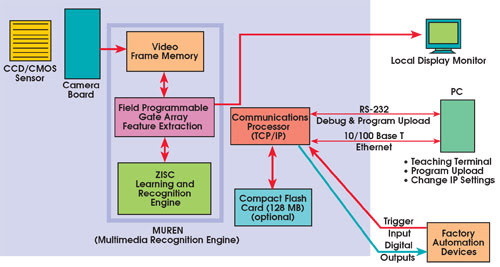Expert systems can simplify programming of complex inspection tasks.
Mike Kelley and Sarah Gelberg, JAI Pulnix Inc.
Although machine vision technology that can solve simple problems has long been available, no machine vision system, until recently, could match a human’s ability to handle highly complex tasks that require sophisticated judgment — at least not at an affordable cost. However, as neural networks are gaining in sophistication, parallel developments in smart cameras are making this technology a feasible option in industrial inspection tasks, such as sorting wood by grain or knots, produce by size or ripeness, or metal by surface finish.
Most modern machine vision systems use complex mathematical algorithms to determine whether a pattern matches a previously trained ideal pattern. Unfortunately, such systems tend to recognize highly variable and pseudo-random patterns as a sequence of individual patterns, which can be time-consuming and difficult to program.
A neural network approach instead looks at this type of pattern as a single model and submits the model to the neural network in parallel. Strengths in pattern recognition, pattern matching and classification tasks make these systems appropriate for signal processing applications — even when problems are nonlinear or poorly defined. The time required to process multiple patterns as a single model has been optimized to a degree by the use of an adaptive radial-based neural technique.
Neural networks go by many names, such as connectionism, parallel distributed processing, neurocomputing, natural intelligent systems, machine learning algorithms and artificial neural networks. Relying on specialized hardware or sophisticated software, these technologies attempt to simulate the multiple layers of simple processing elements called neurons. Each neuron is linked to certain neighbors with varying coefficients of connectivity that represent the strengths of these connections. Learning is accomplished by adjusting these strengths to cause the overall network to produce appropriate results.
A key neural network enabler technology is called zero-instruction-set computing (ZISC). Smart cameras based on this technology, such as JAI Pulnix Inc.’s ZiCam digital camera, can quickly address situations in which the operator, either a human or a machine vision system, must validate or classify highly variable or even near-random patterns.

Cameras based on zero-instruction-set-computing technology can facilitate inspection in applications that must classify complex patterns.
The ZISC neuron model, which is designed for high-speed, complex recognition and classification applications, can be considered the heart of an expert system. There is no need to program the system in a conventional sense, nor are working rules required. Instead, the system learns by example from existing data. It also can learn while performing classification tasks, thus adapting to accommodate objects or situations that were not part of the learning examples.
At the heart of the neural network smart camera is Muren, a patented multimedia recognition engine that implements a high-speed neural network array into an architecture that makes zero-construction-set computing a reality. One benefit of training the system instead of programming it includes a significant reduction in setup time, even for complex inspection tasks.
The quality of the graphical user interface is a key to success. An easy-to-use interface guides end users through the process of capturing an image, defining the field of view, training the smart camera to recognize the appropriate features and, finally, testing its knowledge.
Meet the authors
Mike Kelley is director of the Smart Camera Business Unit at JAI Pulnix Inc. in Sunnyvale, Calif.; e-mail, [email protected]. Sarah Gelberg is a technical writer with the company.